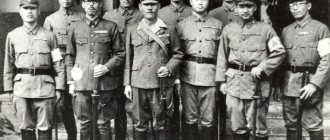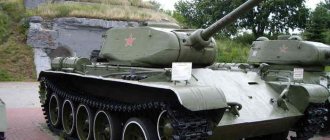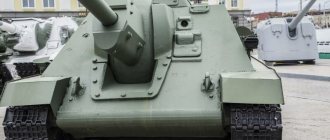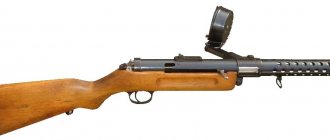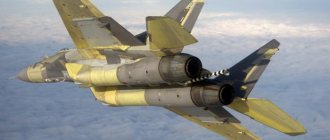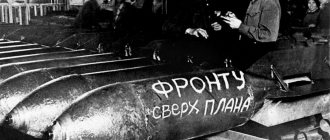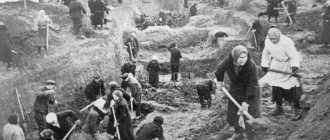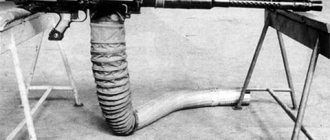Taming the machine gun
It so happens that in any industry, fundamentally new designs that carry revolutionary ideas rarely live a long happy life - they are very quickly toppled from their pedestal by competitors who have grasped the essence and are following the beaten path. The first in its class, the Madsen light machine gun is a happy exception, because it is still in service with a number of countries and does not look like a complete anachronism.
An illustration from an article in Niva magazine with horrific details.
It was quite difficult to surprise and frighten readers of the Russian magazine “Niva” for 1905 - after all, it regularly and, thanks to the telegraph, published materials about the ongoing Russian-Japanese War quite quickly. Defeats in Manchuria, the surrender of Port Arthur, Tsushima... However, the authors of the note about a new type of weapon did not regret using dark colors. The description is so good that it can be quoted without cuts:
“Improved mitrailleuse.
The improvement of deadly weapons goes on and on. We have not yet had time to be sufficiently amazed at the terrible effect of machine guns, “watering the enemy with a stream of bullets,” as we are already told about a new technical invention, which, it seems, is destined to surpass everything hitherto known in the extermination of humanity.
We are talking about the so-called “Rexer mitrailleuse gun”. The Danish engineer Rexer came up with a special gun capable of firing up to 300 bullets in one minute (with some shooting skill). The English king Edward VII, during his last visit to Denmark, was present at the experiments with the Rexer gun and was so pleased with its miraculous qualities that he decided to immediately introduce it into the English army. They say that Japan is also introducing these same “rexers”. It would not hurt, of course, to acquire them in our army.
The "rexer" is something like a large musket, and its dimensions are generally so small that it can be operated by one person without any servants. Its weight reaches 8 kilograms, and any infantryman can easily carry it on a sling, and a cavalryman can easily carry it by attaching it to the pommel of his saddle. A supply of 8,000 cartridges for the Rexer can easily fit on the pack of one horse.
A characteristic feature of the “rexer” is its “magazine”, i.e. room for cartridges during shooting. This magazine has a fan-shaped appearance and is attached above the gun in the form of two slingshots. The gun is equipped with a special tripod, which serves to rest the muzzle on it while shooting. When shooting, the shooter lies on his stomach on the ground, rests the butt on his shoulder, and then he only has to touch the trigger, and within just two seconds the entire magazine containing 25 rounds is already emptied. Shots follow one after another with lightning speed.
But the shots, if desired, can follow one after another and with some intervals if the shooter, for example, wants to aim better. A characteristic feature of the “rexer” is also the fact that it has no recoil at all, and once the sight is taken, it is not disturbed by the shock of the shot.
In general, of all modern mitrailleuses, including the famous Maxim guns and the notorious machine guns, Rexer’s gun is the best, both in terms of ease of use and power, and it can be predicted to have a brilliant career in the brutal wars of the near future.”
We can say that even then there was a glorious tradition in the Russian press of writing about weapons in the wrong way, not quite the way, and not at all the way, but in a way that was “biting” and tickled the reader’s nerves.
It's good that there is only one pack horse depicted for greater effect!
The history of the sample mentioned in the article began long before the Russo-Japanese War. In the 1880s, Danish army captain Wilhelm Madsen and weapons technician Julius Rasmussen began developing a self-loading rifle. The result of their work was one of the world's first self-loading Madsen-Rasmussen M1888, ordered in quantities of several dozen pieces for arming Danish coastal fortresses - the Danish military did not dare to use the new weapon more widely. Later, this rifle (Lieutenant Jens Schoubo also took part in the work on it) turned into the M1896 model. The new rifle, in particular, received a folding bipod and a still integral magazine for 10 rounds mounted on top - thanks to which the cartridges were fed under their own weight.
The Danish Marines became interested in this option. However, another small contract for the fleet for several dozen guns did not suit the enterprising Danes, who in 1898 created the Dansk Riffel Syndikat company specifically for the sale of new automatic weapons. If there was no line of buyers for the rifles, then the next development based on the same solutions aroused much more interest.
In 1901, Jens Schoubo, who had already become an employee of the new concern, patented a machine gun, which aroused very great interest among the man who received the post of Minister of War of Denmark in the same year. However, it would be strange if Wilhelm Madsen forgot about the weapon in the development of which he took an active part. Having become Minister of War and General, Wilhelm, among other things, began to actively “push” the machine gun both in Denmark and on the much more promising world arms market in terms of profits. The Syndicate had reason to hope for commercial success - the Danish machine gun became the first “manual” design and, compared to the majority of machine guns and mitrailleuses on artillery-type carriages of that time, looked very advantageous.
Machine gunners of the army of independent Latvia. Among the whole inflorescence, “Madsen” modestly perched on the right edge.
Structurally, Madsen is a very interesting system. It uses an automation scheme due to recoil energy with a short barrel stroke. In this case, the locking system is implemented in the form of a bolt swinging in a vertical plane, similar to that used in the Peabody rifle.
One of the first countries to become interested in the Danish novelty was Russia. The outbreak of the Russian-Japanese War immediately revealed both the greater effectiveness of machine guns and the urgent need for a sharp increase in the number of this type of weapon. In addition, in the Manchurian theater of operations, cavalry played an important role, for which the “maxims” for a heavy machine were, to put it mildly, burdensome.
Already at the beginning of September 1904, a sample of a Danish machine gun delivered to Russia was tested at the Officer Rifle School. Positive impressions from the test led to the order of the first 50 “machine guns” chambered for the Russian rifle cartridge on September 15, 1904. At the beginning of the next year, the contract was supplemented with an order for another 200 copies. However, this was not the end - first, the border guards asked for another 24 machine guns for the needs of protecting the East China Railway, and then the GAU, “bombarded” from the front by telegrams in the style of “urgently give more machine guns, at least some,” in June 1905 issued a third order - already for 1000 “submachine guns of the 1902 model.”
Soldiers of the young People's Republic of China with a Madsen on a machine.
Since formally neutral Denmark was not supposed to supply weapons to the belligerent, the supply of machine guns was carried out as the transfer of private cargo with the vague wording “iron products”. Some of the machine guns did not come from Denmark at all, but from the London company Rexer Arms Company. In general, the British started producing unlicensed copies of “Madsen” for supplies to the Mexican dictator Porfirio Diaz, but since a more profitable customer turned up... It's nothing personal, it's just business, and the fact that they will shoot from the British machine guns at the Japanese allies is “an everyday matter” .
Most likely, it was the inscriptions on the “British” machine guns that gave birth to the “engineer Rexer” about whom Niva magazine so enthusiastically told its readers. However, it should be noted that Russian journalists only reproduced the message from the French “L'Illustration”.
Secret games around the delivery of machine guns led to the fact that at the Revel customs, having opened one of the boxes with “iron products”, they suspected that the cargo was intended for revolutionaries. It must be said that the customs officers were not so mistaken - in August 1905, the war with an external enemy ended with the signing of the Portsmouth Peace Treaty, but the Madsens, who did not have time to reach the Far East, were immediately useful in the European part of the country. Already at the end of 1905, “machine guns” began to be issued to units that took part in the “restoration of order” - in the absence of a Constitution, the usual autocratic one, so if not the machine guns themselves, then the bullets they fired eventually ended up with the revolutionaries.
If the Russian Empire, having received its “Madsen”, temporarily lost interest in light machine guns, then other customers, on the contrary, lined up at the gates of the Danish “Syndicate”. Already in 1903, “Madsen” was tested in the USA, but, despite the personal presence of Jens Schoubo at the tests, the Americans were not satisfied with the reliability of the demonstrated sample. However, the Danes also had other buyers.
Cuba, Fidel and Madsen...
In Russia, Madsens were remembered again after the start of the First World War. If by this time their own heavy machine gun had already been produced, then the situation with a manual machine gun was not the same. Meanwhile, military operations again, like 10 years ago in Manchuria, confirmed the need and usefulness of having a lighter and more maneuverable machine gun. “After walking around the bazaar” and making sure that there was no particular abundance of handbrake guns against the backdrop of the outbreak of war, the War Ministry started thinking about setting up its own production in Russia.
There were several proposals in this regard - the French offered their “Shosha”, the British - “Lewis”, there were also domestic ones who wanted to receive a tasty government order. But it was the Danish weapons that looked the most attractive. “Syndicate” undertook to build in Russia, while also solving the personnel problem in the form of specialists - from craftsmen and technicians to the technical director. As a result, in August 1916, the ceremonial foundation stone of the “First Russian Joint-Stock Company of Rifle and Machine Gun Factories” took place in the city of Kovrov, Vladimir province.
Ironically, this became the most significant contribution of the Madsens to Russian weapons history, although the plant never produced a single Danish-designed machine gun - its first products were those produced for the new, Soviet government in 1919–1920. Fedorov assault rifles. Subsequently, the Kovrov plant switched to producing Degtyarev machine guns.
Brazilian police with Madsen.
If in Russia the career of the “Madsen” was not entirely successful, then in other countries the “first of the tame” was much more lucky. In total, it was adopted in 34 countries, was actively used in the interwar period, and in the next, World War II, and was produced until the 50s of the last century. The machine gun has remained in service to this day - in particular, in videos and photographs from Rio de Janeiro, Brazilian police are regularly seen with Madsens at the ready. Modernized for modern cartridges, the “oldies” quite successfully cope with the task of increasing the firepower of the police during operations to restore order - just like in Russia, more than 100 years ago.
Users[edit]
- Argentina: Models 1910, 1925, 1926, 1931 and 1935, mostly in 7.65×53mm Mauser [27]
- Austria [28]
- Austria-Hungary [29]
- Bolivia: [4] Model 1925, Mauser 7.65 [27]
- Brazil [30] [ page needed
]: Models 1908, 1913, 1916, 1925, 1928, 1932, 1934, 1935 and 1936, Mauser 7×57mm and Model 1946 in .30-06 [27] - Bulgaria [31] [ page needed
]: Models 1915 and 1927, caliber 8×50mmR Mannlicher [27] - Colombia [ link needed
] - Czechoslovakia: [10] M1922 and M1923, caliber 7.92 Mauser [27] Czechoslovak Legions
[32]
]: [33] Models 1915, 1919, 1922 and 1924, 8mm Lebel [27]
- French Morocco [34]
- German Empire
- Nazi Germany: 1941 and 1942 models, 7.92mm [27]
- Honduras: 1937 and 1939 models, size 7 mm [27]
- Hungary [35]
- Indonesia: M1950 in .30-06 [27]
- Ireland [2]
- Italy [31] [ page needed
]: 1908, 1910, 1925 and 1930 models in 6.5 × 52mm Carcano [27] - Empire of Japan [ citation needed
] - Lithuania [31] [ page needed
]: Model 1923, 7.92 mm [27] - Mexico: [6] 1911 and 1934 models, 7 mm [27]
- Norway: [18] Models 1914 and 1918, Swedish 6.5×55mm [27]
- Netherlands: 1919, 1923, 1926, 1927, 1934, 1938 and 1939 models in 6.5×53mmR. [27] The 1915 model was used by the KNIL as geweermitrailleur
(and
karabijnmitrailleur
for the short version modified in 1926-1927). [36] - Pakistan: M1947, .303 caliber [27]
- Paraguay: M1916 in 7.65 mm [27] [4]
- Peru: M1929, caliber 7.65 mm [27]
- Portugal: [21] Models 1930, 1936 and 1952 in .303 caliber and Models 1936, 1940 and 1947 in 7.92 mm [27]
- Russian Empire: [9] Model 1904 and Model 1915, 7.62×54mmR [27]
- Spain: M1907 and M1922, 7 mm [27]
- Spanish Republic [37]
- Sweden: M1906, M1914 and M1921 in 6.5×55mm [27]
- Thailand: Models 1925, 1930, 1934, 1939, 1947 and 1949 in 8mm Siamese and Model 1951 in .30-06. [27]
- Turkey: M1925, 1926, 1935 and 1937 in 7.92 mm [27]
- United Kingdom: Models 1915, 1919, 1929, 1931 and 1939 in .303 British [27] Colony of Natal: 27 Rexer machine guns used during the Bambatha Rebellion [38]
] various models in version 7.92 [27]
Links[edit]
Quotes
- https://www.arma-dania.dk/public/timeline/_ad_automatvaben_view.php?editid1=2
- ^ abc Carl Martin, Irish Army Equipment, Transport and Armor since 1922, Carl Martin 2002.
- ^ abc Kokalis, Peter. Weapon Tests and Evaluations: The Best of Fortune's Soldiers
. Paladin Press. 2001. pp. 15–16. - ^ a b c d de Quesada, Alejandro (2011). Chaco War 1932-1935 Largest modern conflict in South America. Oxford: Osprey Publishing. paragraph 24. ISBN 978-1-84908-416-1.
- deactivated-guns.co.uk: Madsen machine gun
- ^ ab Jowett, Philip (28 June 2022). The Latin American Wars 1900–1941: "Banana Wars", Border Wars and Revolutions. Action 519. Osprey Publishing. paragraph 44. ISBN 9781472826282.
- Marley, David F. (2014). "Rexer light machine gun". Mexico at War: From the Struggle for Independence to the Drug Wars of the 21st Century
. ABC-CLIO. item 332. ISBN. 978-1610694285 - via Google Books. - Ballou, James L. (October 2008). "The History of the Madsen Machine Gun". Small Arms Review
. Vol. 12 no. 1. - ^ ab Kulikov, Victor (2013). Russian aces of the First World War
. Oxford: Osprey Publishing. pp. 13, 82. ISBN 978-1-78096-060-9. - ^ ab Bullock, David (2009) [First published 2007]. Czech Legion 1914–1920
. Oxford: Osprey Publishing. paragraph 22. ISBN 978-1-84603-236-3. - ^ ab Jowett, Philip (20 November 2013). Chinese Wars: Resurrection of the Dragon 1894-1949
. General Military. Osprey Publishing. pp. 128–129. ISBN 9781782004073. - "A Brief History of the Paraguayan Army". Archived from the original on February 11, 2012. Retrieved November 11, 2014.
- Golpe, Nestor (1970). Calvario y muerte: revisión histórica militar;
narraciones fortineras, 1917-1938 . Artes Gráficas "Armada Argentina", pp. 186-190 (in Spanish) - Hilton, Stanley E. (November 1982). "The Armed Forces and Industrialists in Modern Brazil: The Quest for Military Autonomy (1889–1954)." Latin American Historical Review
.
Duke University Press. 62
(4):634. - Kirk Jr., William A. (2003-03-12). "Brazil". Tanks! Armored Warfare pre-1946
. Florida State University. Archived from the original on 2009-02-27. Retrieved June 21, 2009. - Hilton, Stanley E. (November 1982). "The Armed Forces and Industrialists in Modern Brazil: The Quest for Military Autonomy (1889–1954)." Latin American Historical Review
.
Duke University Press. 62
(4):661. - Lohnstein, Mark (23 August 2018). Royal Netherlands Army in the East Indies 1936–42. Action 521. Osprey Publishing. paragraph 21. ISBN 9781472833754.
- ^ ab Holm, Terje H. (1987). 1940 - igjen?
(in Norwegian). Oslo: Norwegian Armed Forces Museum. paragraph 26. ISBN 82-991167-2-4. - View from the trenches
ASL Magazine Issue May 31-June 2000 - Jaklin, Asbjörn (2006). Nordfronten - Hitlers skjebneområde
(in Norwegian). Oslo: Gyldendal. paragraph 32. ISBN 978-82-05-34537-9. - ^ ab Abbott, Peter (2005). Modern African Wars (2): Angola and Mozambique 1961–1974. Oxford: Osprey Publishing. clause 7. ISBN 978-0-85045-843-5.
- ^ ab "Madsen Light Machine Gun Website". Retrieved November 11, 2014.
- News article about Argentine weapons found in drug dealers [ permanent dead link
] (in Portuguese) - Strategy Page on Madsen Guns.
- ↑
Police rifles break mid-clash.
Actual RJ
(video). YouTube. February 8, 2022. The event occurs at 10:00. Retrieved January 5, 2022. - Dreyfus et al. 2008, p. 83.
- ^ abcdefghijklmnopqrstu vwxyz aa ab ac ad ae af ag Smith 1969, p. 342.
- https://www.hungariae.com/Madsen.htm
- https://www.hungariae.com/Madsen.htm
- Jump up
↑ Gander & Hogg, 1995. - ^ a b c d e Willbanks 2004.
- "FINNISH ARMY 1918-1945: LIGHT VEHICLES PART 2". Retrieved November 11, 2014.
- Vauillier Francois (July 2018). “Le nouvel armement en 7.5mm.” Guerre, Blindés et Matériel
. paragraph 32. - Barbaize, Michelle. “Les goums mixtes marocains et leurs armements. 1908-1956". Association La Koumia
(in French). Retrieved July 4, 2022. - Jump up
↑ Lugosi, József (2008).
"Gyalogsági fegyverek 1868–2008". In Lugosi, Jozsef; Marko, Gyorgy (ed.). Hazánk dicsőségére: 160 Magyars Honvédség
. Budapest: Zrínyi Kiadó. item 382. ISBN. 978-963-327-461-3. - Lohnstein, Mark (23 August 2018). Royal Netherlands Army in the East Indies 1936–42. Militants 521. p. 21. ISBN 9781472833754.
- Rihanna
de Quesada, Alejandro (January 20, 2015).
Spanish Civil War 1936–39 (2): Republican Forces
. Fighters 498. Osprey Publishing. paragraph 38. ISBN 9781782007852. - ↑
Paterson, Hamish (June 2006).
"The Natal Rebellion of 1906: Some Military Perspectives". Military-historical magazine
.
13
(5).
Bibliography
- Dreyfus, Pablo; Guedes, Luis Eduardo; Lessing, Ben; Bandeira, António Rangel; Nascimento, Marcelo de Souza; River, Patricia Silveira (2008). Small arms in Rio de Janeiro: guns, buybacks and victims. Switzerland: Small Arms Survey. ISBN 2-8288-0102-0. Retrieved January 5, 2022.
- Gander, Terry J.; Hogg, Ian W. (May 1995). Jane's Infantry Weapons 1995/1996
(21st ed.). Jane Information Group. ISBN 978-0-7106-1241-0. - Smith, Joseph E. (1969). Small Arms of the World (11th ed.). Harrisburg, PA: Stackpole Company.
- Willbanks, James H. (2004). Guns and War - An Illustrated History of Their Impact
. ISBN 1-85109-480-6.
